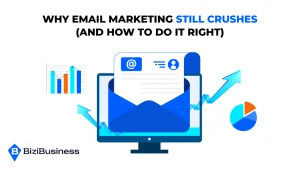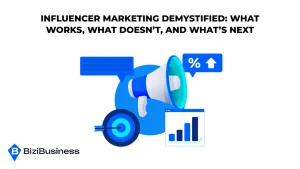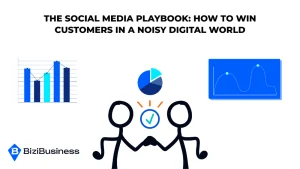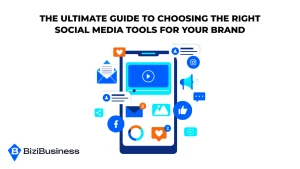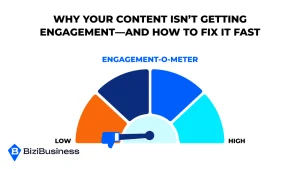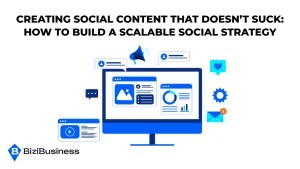BiziTopics
From Blog to Checkout: How eCommerce Brands Turn Content Into Revenue
BiziBusiness
Jul 8, 2025
23 min read
Content doesn’t convert by accident.
And in eCommerce, it’s not enough to just write a blog post, slap a product mention in the middle, and hope for sales.
The truth? Most eCommerce content is invisible, irrelevant, or just plain ineffective.
Why? Because it wasn’t built with intent.
It was built for SEO checklists, social filler, or because “marketing said we need to blog.”
But content—when done right—isn’t just a branding tool. It’s a scalable, revenue-generating engine that attracts, educates, and guides customers from discovery to checkout.
This guide breaks down what smart eCommerce brands are doing differently:
- How they create content that ranks and sells
- How they turn blogs into product funnels
- How they measure what actually moves revenue
You’ll learn how to align your content strategy with your customers’ buying journey—so your blog doesn’t just get traffic… it gets conversions.
Let’s turn your content into one of your most powerful sales assets.
Why “Content for Content’s Sake” Is a Dead Strategy
If you’re still publishing two blog posts a week “because we’re supposed to,” you’re doing it wrong.
The internet is overflowing with content—and most of it is noise. AI tools are mass-producing keyword-stuffed articles by the second. Freelancers are cranking out copy that sounds decent but says nothing. And brands are hitting “publish” on content that nobody’s reading, clicking, or converting from.
Here’s the problem: none of it drives revenue.
What Happens When You Create Content Without Strategy
- You attract the wrong visitors—people who bounce fast and never buy.
- Your time, money, and resources are spent feeding the content machine—with no return.
- You clutter your site with low-quality pages that hurt your brand’s authority.
- Worst of all: You get stuck thinking content marketing “doesn’t work.”
But it does—when it’s built around real intent, real buyers, and a real goal.
The Fluff Factory: How Content Became Worthless
For the last decade, content marketing was focused on one thing: volume.
Brands were told to publish frequently, target long-tail keywords, and keep feeding Google. That strategy used to work—until it didn’t.
Now, thanks to:
- AI flooding the SERPs
- Smarter search intent signals
- Increased consumer skepticism
- And Google’s content quality updates…
Low-quality content = zero visibility + zero ROI.
The Shift: From “More Content” to “More Strategic Content”
Winning brands have made the pivot.
They’ve stopped publishing for publishing’s sake—and instead create content with purpose. That means:
- Serving the right audience at the right moment in their journey
- Delivering real value that answers questions, overcomes objections, and builds trust
- Embedding clear, compelling paths to purchase (not passive CTAs buried in paragraph 8)
This is the difference between a blog that ranks and a blog that sells.
If your content doesn’t attract, engage, and convert—it’s not content marketing. It’s just noise.
But don’t worry—we’re just getting started.
What Makes Content Actually Convert in eCommerce

It’s not enough for content to rank. It has to sell.
That means more than checking off an SEO checklist or embedding a product link at the bottom of a blog. High-converting eCommerce content is engineered with buyer psychology, user intent, and persuasive storytelling in mind.
Here’s what separates content that collects clicks from content that drives checkouts:
1. Intent-Driven Content > Keyword-Driven Content
Too many brands still write content for keywords, not customers.
The result? Pages that technically rank—but don’t convert—because they miss the searcher’s true intent.
Ask yourself:
- What problem is the customer trying to solve with this search?
- What mindset are they in—awareness, research, comparison, or ready to buy?
- How can my product be part of the solution, not just an add-on?
When your content meets them where they are, conversions follow.
2. Trust-Building Is the New CTA
People don’t convert on the first click because of features—they convert because of confidence.
Every piece of content should work to reduce friction and build trust by:
- Answering objections before they’re asked
- Embedding social proof, testimonials, or UGC
- Educating instead of hard-selling
Remember: conversion doesn’t always happen on the first touch—but your content should move the buyer closer to “yes”.
3. Copy That Guides, Not Just Informs
Strong content doesn’t just dump information. It guides users step-by-step toward a decision.
That means:
- Clear, benefits-first headlines
- Skimmable formatting (because no one reads giant walls of text)
- CTAs placed where they make sense, not just at the end
Whether you’re linking to a collection page, a product, or a quiz—the CTA should feel like a next logical step, not an interruption.
4. Content That Aligns With Product Positioning
Your content should reflect how your product is uniquely positioned to solve the buyer’s problem.
For example:
- A skincare brand shouldn’t just write “5 Tips for Clear Skin”—they should explain why their ingredient stack outperforms other routines.
- A DTC coffee company can write about “How to Brew Barista-Quality Coffee at Home” while naturally guiding users toward their product as the solution.
Every post is a chance to reinforce your value proposition—subtly, but consistently.
The Litmus Test:
In chemistry, a litmus test instantly tells you whether a substance is acidic or not.
In marketing, a litmus test is a quick, high-impact way to evaluate whether something is doing what it’s supposed to do.
In this case:
“Does this content actually help move someone closer to buying?”
It’s your BS detector. Your reality check. The filter that separates fluff from function.
If your content doesn’t build trust, meet intent, and nudge action—it’s not conversion content. It’s just filler.
The eCommerce Content Funnel: A Breakdown (Expanded)
If you want your content to do more than just “get clicks,” you have to treat it like a funnel—not a free-for-all.
Think of it like a relationship:
- Top of Funnel = the introduction
- Middle of Funnel = the trust-building phase
- Bottom of Funnel = the proposal
Try to rush the process, and you’ll scare people off. Move them through with value, and they’ll buy into you—not just your product.
Let’s walk through how top eCommerce brands use each stage to turn browsers into buyers
Top of Funnel (TOF): Discovery & Awareness
This is where strangers become curious.
They’re not looking for your product yet. They’re looking for answers, inspiration, or solutions to problems. If your brand shows up here helpfully and authentically, you’ve earned their attention—and started a relationship.
- The Job:
- Get discovered via search, social, or shared links
- Deliver actual value—not a sales pitch
- Make the reader think: “Huh, this brand gets me.”
- Smart Brands Know:
Top-of-funnel content isn’t about the hard sell. It’s about relevance. Show you understand their world before introducing your solution.
- Example:
A sustainable apparel brand writes:
“How to Build a Minimalist Wardrobe That Actually Works”
They don’t lead with their product—they lead with value. But the article features their capsule collection, styled subtly.
Result: Trust built, brand remembered.
Middle of Funnel (MOF): Consideration & Evaluation
Now they know you. Maybe they’ve browsed. Maybe they followed you on Instagram. Maybe they subscribed to your email list.
They’re considering you—but you’re not the only one in the running.
This is where you educate deeper, prove your value, and show why you’re different.
- The Job:
- Address objections
- Clarify benefits
- Build authority and likability
- Smart Brands Know:
This is where your content needs to say:
“Here’s why our product isn’t just another version of what you’ve seen—here’s why it’s the one you’ve been looking for.”
- Example:
A supplement brand publishes:
“What to Look for in a Clean Protein Powder (and Why Most Brands Get It Wrong)”
It breaks down common industry BS, highlights what to avoid, and subtly points to their clean-label formula.
Result: Brand credibility skyrockets. The buyer starts to lean in.
Bottom of Funnel (BOF): Purchase & Conversion
This is the “buy now” moment—but that doesn’t mean it has to scream SALE in all caps.
At this stage, your content should remove final friction, validate the buyer’s decision, and nudge them confidently across the finish line.
- The Job:
- Remove doubts
- Reinforce proof
- Drive the final action
- Smart Brands Know:
People want to feel smart and secure when buying. Bottom-funnel content should make them feel like they’re making the right choice—not just taking a gamble.
- Example:
A home fitness brand creates:
“Why Over 10,000 Runners Switched to [Brand’s] Smart Recovery Mat”
It’s packed with social proof, video reviews, expert quotes, and even a limited-time offer banner.
Result: Doubts erased. Credit card out. Purchase made.
Post-Purchase (Retention & Advocacy)
This is where most brands drop the ball. But the smartest ones? They know the real profit is in what happens after the first sale.
This content isn’t about acquisition—it’s about loyalty, LTV, and turning buyers into your best salespeople.
- The Job:
- Improve product experience
- Encourage repeat purchases
- Fuel word-of-mouth
- Smart Brands Know:
The post-purchase experience is your chance to overdeliver. A great guide, a thoughtful follow-up, or an exclusive content drop makes customers feel seen.
- Example:
A meal-prep company sends:
“5 Delicious Ways to Use This Week’s Ingredients (with bonus macros & storage tips)”
It boosts product usage and customer retention—while making the user feel supported, not sold to.
Great content maps perfectly to customer intent, meets them where they are, and gently—but purposefully—guides them forward.
SEO + Content = Scalable Organic Growth
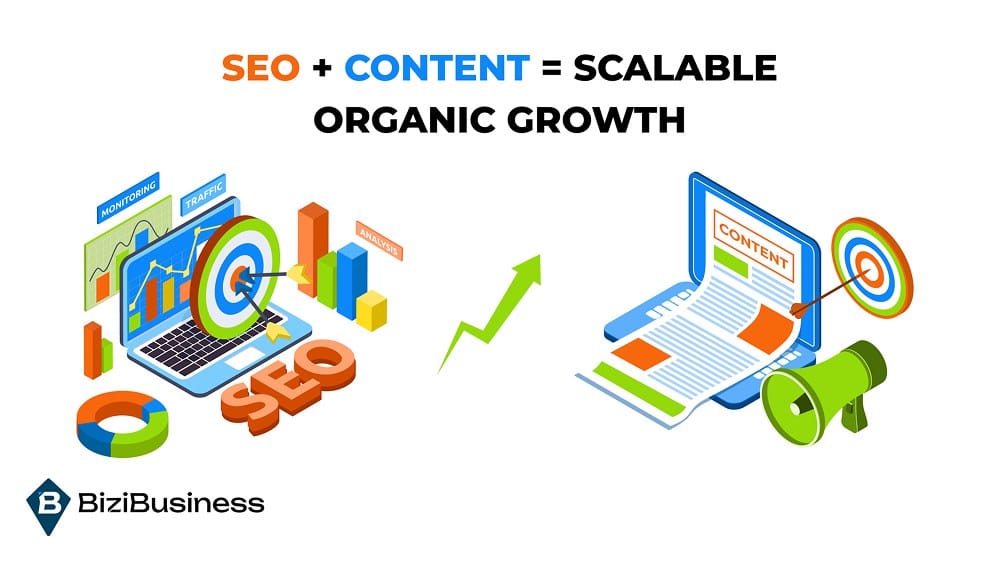
You can write the most helpful, persuasive content on the planet—but if no one finds it? It’s just sitting there, collecting dust on your site.
That’s where SEO meets strategy.
And no—we’re not talking about keyword stuffing, outdated checklists, or hoping Google picks you out of a crowd. We’re talking about intent-first SEO, built into content that’s meant to rank, resonate, and convert.
Here’s how top eCommerce brands are turning search engines into a long-term sales channel:
SEO Is Not Dead—But the Old Tactics Are
Let’s get this straight: SEO still drives the majority of high-converting organic traffic for eCommerce. But the game has changed.
Outdated SEO advice sounds like:
- “Use your target keyword 37 times.”
- “Write 1,000 words for every blog post.”
- “Just add more backlinks.”
Today? Google (and buyers) want quality, clarity, and usefulness.
Brands that win in 2025 are creating content that:
- Matches search intent exactly
- Solves problems better than competitors
- Loads fast, reads well, and builds trust instantly
Keyword Intent Mapping = Your Secret Weapon
Every keyword has a hidden signal behind it: What is the person searching for really trying to do?
That’s called search intent—and if you miss it, your content won’t rank OR convert.
Example Breakdown:
| Keyword | Intent Type | Best Content Format |
|---|---|---|
| “how to brew cold coffee” | Informational | TOF blog post with product link |
| “best cold brew maker 2025” | Commercial | MOF comparison guide or product round-up |
| “buy cold brew kit online” | Transactional | BOF product page or shoppable landing page |
Right keyword → Right content → Right results.
Repurpose, Refresh, and Interlink
You don’t always need new content—you need smarter content.
High-growth brands use SEO to breathe life into what they already have:
- Update older posts with new stats, images, and product links
- Repurpose high-performing blogs into TikToks, reels, emails, and ads
- Interlink TOF, MOF, and BOF content to guide users deeper down the funnel
This boosts session time, crawl depth, and most importantly—conversions.
Technical SEO = A Silent Sales Tool
Google can’t rank what it can’t read.
You don’t need to be a dev, but you DO need to check these:
- Mobile-friendliness
- Page speed (3 seconds or less is the goal)
- Clean URL structures
- Optimized meta titles & descriptions
- Schema markup for product pages (hello, rich results!)
SEO isn’t just for blog posts—it impacts your collection pages, PDPs, and even your homepage.
SEO + Content = Compounding ROI
Unlike paid ads that stop the second your budget does, SEO-powered content keeps working.
One well-optimized blog post can:
- Drive thousands of monthly visits
- Rank for hundreds of long-tail variations
- Continuously bring in buyers who are already looking for what you sell
And when those blog visitors are guided into your funnel with the right CTAs and links?
That’s when your content starts paying rent and dividends.
And if you’re serious about using SEO to fuel long-term, compounding growth:
➡️ Check out our full guide on eCommerce SEO
Content That Moves the Needle: Formats That Work
Let’s be real: not all content pulls its weight.
If you’re still publishing 800-word blog posts with no product tie-in, no structure, and no value beyond “informative,” you’re likely wasting time.
Winning content in eCommerce isn’t just written—it’s engineered to influence behavior. The format matters just as much as the message.
Let’s break down the content types that actually move users toward conversion:
Product-Led Blog Posts
These are blog posts designed with one goal: to naturally showcase your product as the solution.
Think less “article,” more “strategic pre-sell.”
Examples:
- “Why [Product] is the Secret to [Desired Outcome]”
- “Top 5 Tools for [Pain Point]—And Why Ours Is #1”
- “Customer Spotlight: How Jane Used Our [Product] to Solve [Problem]”
Shoppable Gift Guides & Roundups
Search traffic LOVES curated content.
If you sell multiple SKUs or have bundles, gift guides are pure gold—especially around seasonal campaigns, holidays, or niche interest areas.
Formats:
- “10 Gifts for the [Type of Person] in Your Life”
- “Best [Product Type] for Under $50”
- “Everything You Need for [Occasion/Event]”
Add:
- CTA buttons below each product
- Star ratings, quick reviews, badges, and urgency (“Only 3 left!”)
Email-Optimized Blog Content
Not every subscriber is ready to buy. But a smart blog post can nurture that list and bring them closer to checkout.
Design content to:
- Be easily summarized in an email
- Lead with curiosity-driven headlines
- Encourage click-through with “Read more” or “See how it works” buttons
Short-Form Video + Visual Storytelling
Today’s shoppers want to see, not just read.
Embed:
- Explainer videos
- TikTok-style product demos
- Lifestyle GIFs or motion graphics
Especially on mobile, video can triple time-on-page and double conversion rates when paired with the right CTA.
Evergreen + Timely Content Mix
Smart brands balance long-lifespan content (like “How to Choose the Right Mattress”) with time-sensitive hits (like “The 2025 Eco-Gift Guide”).
This ensures you:
- Stay relevant in searches
- Capitalize on seasonality
- Keep content traffic flowing year-round
If your content isn’t strategic in format, you’re missing half the opportunity. These content types aren’t just engaging—they’re built to guide readers toward one thing: action.
Content Distribution: If You Build It… You Still Have to Promote It

Let’s get honest for a second:
You worked hard on that content.
You researched the topic. Wrote it with intent. Optimized it for SEO.
Maybe even threw in a killer CTA or two.
Then what?
You hit “publish”… and moved on.
That’s the silent killer of content ROI right there—assuming great content promotes itself.
But in a world where thousands of articles, videos, and posts are launched every hour, even the best content needs a push.
High-performing eCommerce brands know that hitting “publish” is just the beginning. What separates content that fades from content that fuels sales is one key factor:
➡️ Distribution.
Here’s how top brands make sure every blog post, guide, or story actually gets seen—and gets results.
Email: The Distribution Channel You Already Own
Your email list is gold. These people already know you. They already signed up. They’re waiting for something valuable.
So give it to them.
Smart brands use blog content to:
- Educate subscribers before a launch
- Re-engage inactive segments
- Nurture new leads from welcome flows
- Upsell past buyers with helpful “how-to” or product comparison content
The trick? Don’t just send them content—send them reasons to care.
Subject lines that spark curiosity. Previews that show value. And a strong CTA that leads them to the full piece (or product).
Paid Social: Pay to Play—Strategically
Not every blog post is worth putting money behind. But when a piece starts gaining traction organically? That’s your signal.
Top eComm brands are boosting content that already proves it resonates—then using it to:
- Retarget warm traffic (blog readers, email clickers, cart abandoners)
- Educate cold audiences at the top of funnel with value-first ad campaigns
- Test ad angles before turning them into full-blown sales creatives
Why this works: People don’t ignore value. Content-led ads feel like help, not hype—and that builds trust before the sell.
Repurposing: One Piece = 10 Assets
A high-performing blog post is more than a traffic magnet—it’s a creative goldmine.
Brands that repurpose win because they extend the life (and reach) of every message.
From one article, you can create:
- A TikTok or Reel breaking down the “Top 3 tips” in 30 seconds
- A carousel post summarizing key takeaways on Instagram or LinkedIn
- A short email teaser linking to the post
- A Pinterest pin with a “Save for later” CTA
- A Twitter/X thread teasing stats, ideas, and calls to comment
The rule: Change the format, not the message. Deliver value where your audience already spends time.
Influencer & Affiliate Distribution: Let Others Share the Load
Got brand reps? Ambassadors? Affiliates?
Your content can do more than serve your audience—it can serve theirs.
Top brands equip partners with:
- Ready-to-share blog content links
- Swipe copy for emails or social captions
- UTM-tagged versions of content to track ROI per partner
This extends your reach, builds authority, and fuels earned media at scale—without you lifting a finger.
Don’t Ignore Internal Distribution (a.k.a. Your Own Site)
Most eComm brands treat content like a one-way street: traffic comes in, maybe someone clicks, and they leave.
But internal distribution guides users where they need to go—especially when they’re already on your site.
Try this:
- Link product pages to related blog posts for deeper education
- Link blog posts back to relevant PDPs, collection pages, or gift guides
- Add content teasers to your homepage, pop-ups, or thank-you pages
This keeps users in your ecosystem longer—and the longer they stay, the more likely they are to convert.
Tools to Streamline Your Distribution Game
Want to avoid dropping the ball post-publish? Set up systems.
Use:
- Klaviyo / ConvertKit / Drip for automated email workflows tied to content
- Buffer / Later / Hootsuite for multi-channel social scheduling
- Google Looker Studio / GA4 to track content performance, traffic sources, and assisted conversions
Remember: Distribution is not a one-time blast—it’s an ongoing system.
Every blog post should be treated like a campaign. Plan its rollout. Push it across platforms. Repurpose it. Retarget with it.
Content is an asset. But only when it gets seen, shared, and clicked.
Now, let’s focus on what happens after someone lands on your content
Conversion-Driven Content UX
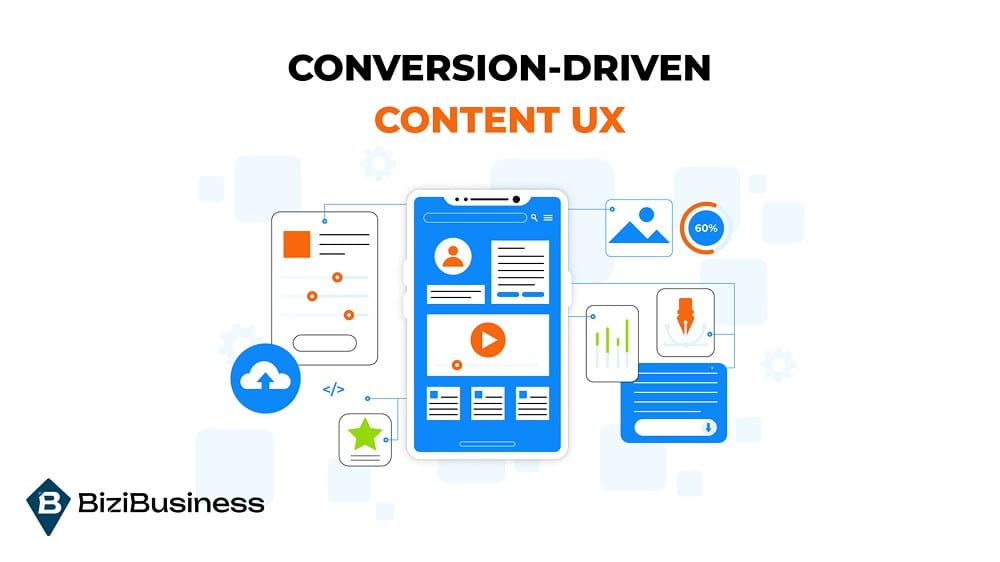
You’ve done everything right so far.
You’ve written high-intent, trust-building content. You’ve optimized it for SEO. You’ve distributed it like a pro.
Someone clicked.
They’re on your blog.
They’re reading.
This is the moment where most brands drop the ball.
Because here’s what they don’t realize:
The way your content looks, feels, and flows has a direct impact on whether someone converts—or clicks away.
You might have the right message. But if the experience is clunky? The sale is gone.
Conversion-driven content UX isn’t about flashy design. It’s about frictionless flow—removing distractions and guiding your reader toward the next step with clarity and ease.
Let’s break down what that looks like in practice.
Mobile-First or You’re Losing Money
More than 70% of eCommerce content traffic comes from mobile.
If your beautifully written blog post takes 5 seconds to load, has tiny fonts, or hides CTAs under pop-ups… you’ve already lost them.
Mobile UX non-negotiables:
- Fonts readable without zooming
- Tap-friendly CTA buttons
- Pages that load in under 3 seconds
- No intrusive pop-ups or banners
Always preview your content on a phone. If it’s clunky, your conversions will suffer.
Design for Skimmers, Not Scholars
Nobody is reading your blog top to bottom on their phone while sipping coffee.
They’re scanning. They’re hunting for something useful. They’ll scroll past 3 blocks of text faster than you can say “bounce rate.”
So make your content easy to digest:
- Use bold headlines to structure the flow
- Break ideas into short paragraphs (2–3 lines max)
- Add bullet points, icons, or checklists
- Sprinkle in visuals: product photos, UGC, short-form videos
- Use highlighted pull quotes or standout stats to grab attention
The faster they find what they’re looking for, the more likely they’ll trust your product to solve their problem.
CTAs: The Missing Link in Most Content
You know the sad reality?
Most blogs get the click… and then leave the reader hanging.
If your content doesn’t clearly guide someone to the next logical step, you’re leaving money on the table.
Strategic CTA placement:
- Mid-article CTAs: Light-touch nudges like “See how this works in our [Product Name]”
- Sticky sidebars: Helpful buttons that follow the scroll but don’t interrupt it
- End-of-post offers: Direct but benefit-led (“Start your free trial,” “Shop the bundle,” “Take the quiz”)
Your CTA isn’t just a button—it’s a bridge from value to action.
Trust Signals: Build Confidence With Every Scroll
People won’t buy unless they feel safe.
And your content is the perfect place to plant those trust-building cues—especially for first-time visitors.
Embed:
- Review snippets (“Over 10,000 5-star reviews”)
- Icons for free shipping, guarantees, or secure checkout
- Media mentions or influencer pull quotes
- UGC that proves the product in real life
Trust doesn’t just live on your homepage. Infuse it into every scroll of your content.
Avoid the “Blog Trap”
What’s the blog trap?
It’s when a reader finishes your post… and there’s nowhere to go.
No product suggestions. No CTA. No related links. Just dead-end content.
You worked so hard to get them here. Don’t lose them now.
Avoid it by:
- Internally linking from content to product pages, quizzes, or gift guides
- Suggesting “Next Reads” based on behavior or tags
- Using sticky menus or exit pop-ups with value-driven offers
Your blog should feel like a highway—not a cul-de-sac. Every turn should lead them somewhere deeper.
Content doesn’t convert just because it’s helpful.
It converts because it’s helpful, usable, and designed to guide action.
So don’t stop at writing strong content—design an experience that moves people through it.
When you combine story with structure, insight with flow, and strategy with simplicity—you don’t just get pageviews. You get buyers.
Content Metrics That Matter
Stop Tracking Vanity. Start Measuring What Drives Sales.
So you’ve published the content. Promoted it. Optimized the UX.
Now what?
It’s time to track performance. But not just with surface-level stats like “pageviews” or “likes.”
Because let’s be real:
Traffic means nothing if it doesn’t translate into revenue.
High-performing eCommerce brands don’t just create content—they measure its impact on the entire customer journey. That’s how they improve what works, kill what doesn’t, and scale results.
Here’s what they’re tracking
Traffic Quality Over Quantity
Most brands obsess over traffic volume. But smart brands ask:
“Is this the right traffic?”
Metrics to track:
- Bounce Rate (lower = more engaged)
- Time on Page (shows if people are actually reading)
- Pages Per Session (signals deeper interest)
- New vs Returning Visitors (returning = higher intent)
A blog that brings in 500 high-intent readers who convert is worth more than one that brings 10,000 who bounce.
Session-to-Sale Rate
This is your conversion rate from content to checkout.
It shows how many users landed on your content and eventually completed a purchase—whether immediately or via a retargeted ad, email, or referral.
Use GA4 to set up events that track:
- Scroll depth
- Product page clicks from blog posts
- Add-to-cart and purchase actions after content views
The goal isn’t just traffic—it’s momentum toward the buy.
Assisted Conversions (Your Hidden ROI Hero)
Not every piece of content will close the sale. But many of them play a key role in influencing it.
That’s where assisted conversions come in.
This metric tells you:
- Which blog posts or landing pages helped someone before they bought
- How many touches it took before conversion
- What content keeps showing up in high-value customer paths
Use this to defend TOF and MOF content when the sales team asks, “But did it convert?”
Top Pathways to Purchase
This is the map of how people move through your funnel.
Track:
- Which pages are the most common entry points
- Where users go after reading a blog
- What % of readers click to a product page, quiz, or collection
- What content leads to the highest LTV customer segments
Look for patterns—then build more of what’s working.
Email & Lead Capture Conversions
For brands with longer sales cycles or high-AOV products, the real win is getting content readers to opt into your list.
Track:
- Blog-to-quiz conversions
- Blog-to-lead magnet downloads
- Scroll-triggered pop-up opt-ins
- Content upgrades (PDFs, checklists, gift guides)
Email subscribers = future customers. Content can be your best list-builder.
Creative Testing Feedback Loops
Every blog post is also a test bed for:
- Headlines
- Hook angles
- Story structure
- CTAs and offer language
Use your best-performing content to inspire paid ad copy, email subject lines, and landing page frameworks.
If a blog title gets a 12% CTR from email? Try that hook in a Facebook ad.
If a content CTA drives 300 clicks a week? Test it on your homepage.
Content isn’t just a channel—it’s an optimization lab.
When you know your numbers, you know your next move.
Turn Content Into a Growth Engine
This Isn’t Just Content. It’s Conversion Strategy.
If there’s one thing we hope you’ve taken from this guide, it’s this:
Content marketing for eCommerce isn’t about creating more—it’s about creating strategically.
Because in today’s market, fluff doesn’t cut it.
You’re not writing for clicks. You’re writing for buyers.
High-growth eCommerce brands aren’t just blogging because “marketing says we should.”
They’re building content that ranks, resonates, and drives action.
They treat their blog like a funnel.
They treat their emails like sales tools.
They treat their SEO like lead gen.
They treat their brand story like a conversion lever.
And they win because of it.
So, let’s recap what works:
- Start with intent. Every piece of content should solve a specific problem for a specific customer at a specific stage of their journey.
- Build a full-funnel content ecosystem. TOF brings them in, MOF builds trust, BOF closes the sale.
- Marry SEO with storytelling. Rank with purpose, write with clarity, guide with CTAs.
- Design for action. UX matters. Mobile matters. Friction kills conversions.
- Distribute like a campaign. Don’t just publish—push your content into the right feeds, inboxes, and scroll paths.
- Measure what matters. Not just pageviews. But scrolls, clicks, opt-ins, assisted conversions, and sales.
Do that consistently, and your content stops being “just marketing.”
It becomes a growth engine.
Subscribe to Newsletter
Unlock your creativity and stay up to date on marketing tips
